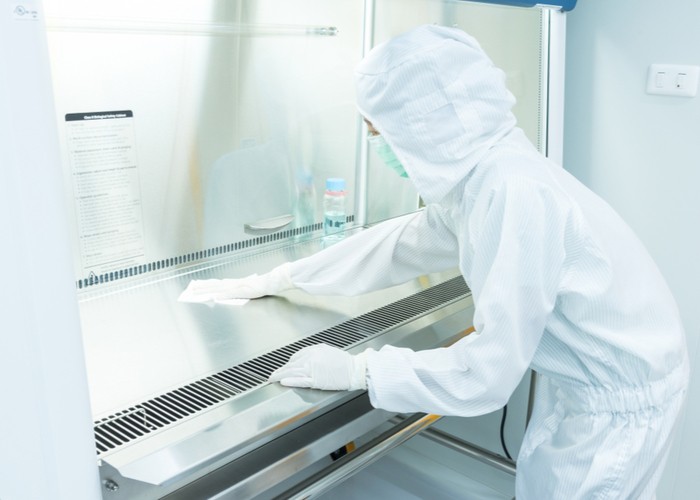
If you are planning to reopen a lab after the Covid-19 crisis, please contact us and we are happy to help.
Lab decontamination is an important responsibility that comes as part of lab occupancy. Whether you are vacating a lab, moving to a new facility or decontaminating an existing space, decontamination is a major consideration for several reasons. These include:
- Integrity of the space: A space free of contamination is necessary to ensure that any work done in a lab can be validated, verified, documented and repeated. Results generated in a contaminated space cannot be taken at face value and must be discarded.
- Product safety: Microbial contamination can make many reagents or stored products unusable. It is critical to verify that storage space is properly decontaminated after any kind of bioburden is discovered. If left untreated microbial contamination can spread to adjacent areas and create additional problems.
- Personnel safety: Microbial contamination can present grave danger to lab personnel. It is critical to verify that anyone working in a lab is aware of what is present so that he or she can take proper precautions. The danger of microbial contamination means that even material that may be benign can pose a risk if not properly decontaminated.
- Regulatory compliance: Without proper decontamination, lab operators cannot be sure that their space will meet regulations. Decontamination may also be a legal requirement when vacating a space.
- Lease compliance: In addition to regulatory compliance, lab decontamination may be required to comply with the rules of a lease.
Next, we’ll look at some common lab decontamination scenarios, and the lab decontamination challenges associated with them.
Common Lab Decontamination Scenarios
The following situations are some of the most common times when lab decontamination would be required:
- Vacating a facility: When vacating a facility, the lab owner may stipulate that you, as the tenant, are responsible for decontamination. Be sure to fulfill these obligations to prevent any legal issues. As the lab user, you are equipped with the best knowledge of what decontamination will be required.
- Entering a facility: It is not always possible to be 100% sure that a facility into which you are moving has been properly decontaminated. The safest option is to conduct testing and decontamination to eliminate unwanted reagents or microbes.
- After an accident: If a major leak or spill has occurred, it may be necessary to decontaminate the space. While you might focus only on the incident at hand, it could also be a good opportunity to conduct a more thorough decontamination.
- During breaks or downtime: For example, in academic settings, lab spaces are frequently decontaminated during student breaks, to help ensure safety for the students and the integrity of any research done.
- Prior to maintenance: When working with dangerous biological materials many contractors will refuse to enter a space unless it has been properly decontaminated. A common practice for biohazardous laboratories is to have the space decontaminated just before having several vendors visit in a small time period to conduct routine maintenance.
The Lab Decontamination Process
Depending on the scenario, the lab decontamination process may have several steps and facets to it. Whether you are leaving a facility, moving into one or decontaminating an existing space, the below points should factor into every process:
- Review documentation of media, reagents, and other materials in use: Whether this is your documentation or that provided by a previous occupant, this should be your first step in understanding how to plan your decontamination. A common challenge in this step is unavailable documentation. In this case, take other steps to try and determine what may be present in the space, such as contacting previous tenants or the leaser of the space.
- Conduct necessary tests: Examples of common test to discover contaminants are: Radiation surveys, viable sampling, and chemical residue sampling. Finding the source of the contamination is key during this step.
- Assess decontamination needs: With knowledge of the contaminants that could be present, the next step is to evaluate what must be decontaminated. This could include biological or chemical hoods, non-porous surfaces, containers, biological storage, entire laboratory spaces, and more. Be sure to understand and address every aspect of the space that must be decontaminated.
- Create a plan: Based on your assessment, develop a concrete, step-by-step plan for how to approach the decontamination. Consider logistics, potential for cross-contamination, safety of staff, and more.
- Remove: If necessary, remove or dispose of containers and other items.
- Complete the decontamination process: Use industrial-grade cleaners and any necessary chemicals required to neutralize or remove other material.
At Technical Safety Services, we possess a deep understanding of the decontamination process — including generation of customized protocols specific to your unique situation, knowledge of local regulations, and best safety practices. We are ready to offer our expertise and carefully developed processes to help your operations run more smoothly. For more information, view our other services or contact us today.

